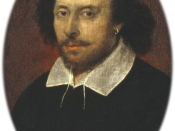Let me not to the marriage of true minds Admit impediments. Love is not love Which alters when it alteration finds, Or bends with the remover to remove: O, no! it is an ever-fixed mark That looks on tempests and is never shaken; It is the star to every wandering bark, Whose worth's unknown, although his height be taken.
Love's not Time's fool, though rosy lips and cheeks Within his bending sickle's compass come; Love alters not with his brief hours and weeks, But bears it out even to the edge of doom.
If this be error and upon me proved, I never writ, nor no man ever loved.
William Shakespeare 1609 William Shakespeare, without question, is heralded as one of the most accomplished playwrights who ever lived. Many within literary circles consider him to be the greatest playwright ever rendered from England. Although the exact number of his plays remain a mystery (history has posthumously bequeathed him thirty-seven), his works continue to be clamored for by audience and actor alike, often providing a standard by which other plays and characterizations are judged.
Aside from his plays, Shakespeare also composed 154 sonnets, a form of lyrical poetry. The word sonnet is derived from the Italian word sonnetto, or little song, a means of telling a short story or presenting a philosophical idea. This analysis paper will attempt to focus on one particular sonnet titled "Let me not to the marriage of true minds"�, written in 1609. I will offer a brief biography of the author, provide a stylistic description of the sonnet, and then describe what I perceive the piece to mean by examining the verses and then the work encompassed.
William Shakespeare was born in Stratford, England in 1564. He was the third of eight children...


